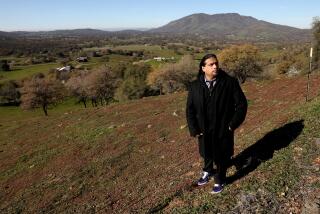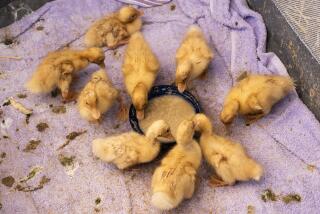Ducks Redux : Plaque, Statue Unveiled to Honor Birds Slain by Game Officials
- Share via
It’s duckling season along the canals of Venice. So it’s not uncommon for Lina Shanklin to get a knock on the front door of her house on the edge of Linnie Canal from a neighbor cradling an abandoned duckling and asking for Shanklin’s help.
On Saturday morning, Shanklin was kibitzing with neighbors in Linnie Canal Park, a landscaped island of grass and playground next to the canal, when she got another rescue call.
The president of the neighborhood’s Venice Canal Conservancy, she had just finished her remarks at the dedication of the newly renovated park.
The highlight was the unveiling of a plaque and statue memorializing the “kill,” as it’s called here, of about 500 ducks in the canals and nearby ponds by the California Department of Fish and Game two years ago this month. Fish and Game officials were responding to fears of health problems among the ducks.
Two friends approached, one with a fuzzy runt of a duck no more than a couple of days old, abandoned and weak, his eyes droopy, his head still.
“I’ve got a medicine dropper and electrolyte solution at home. He needs water,” said Shanklin as she led the rescue party to her back yard. She stirred up a bowl of greenish, watery fluid. While her friend, Linda Tomchin, cradled the bird, Shanklin gently forced open the tiny beak and fed two droppers full of solution down the duckling’s throat.
He squeaked his protest, but a minute later he perked up, eyes wide, soon to return to the life of a small duck in Venice--dodging sea gulls and frisky dogs, and finding fresh water and solace from pampering human neighbors.
About 100 ducks paddle the Venice canals today. Shanklin says they are the descendants of about 30 ducks that evaded the game wardens’ infamous 1993 roundup--proof, residents argued Saturday, that the doomed ducks were never a health hazard.
Two years ago, the state government’s decision to prevent the spread of an avian virus by killing surviving ducks thought to be carriers galvanized the residents who front this network of canals.
They formed the Venice Canal Conservancy and argued that the ducks posed no threat to other wildfowl. They lined the canal bridges in protest and blew whistles to scare away ducks and thwart the roundup.
*
Their highly publicized actions were in vain, but their vigilance remains. Today they consider themselves well-versed in duck rescue and wildlife education.
And, yes, they know you think they’re crazy. “When you get active, people like to call you a duck lover,” said Shanklin, who is a screenwriter.
“But most everyone on the conservancy is active in other issues--the homeless, social causes. And if you live here, you’re intimate with all of this wildlife.”
Up and down the canals, residents put out large pans of fresh water--the canals are salt water--for the ducks to drink and bathe in.
Shanklin’s side yard is a stop for several ducks and three geese who munch on the leaves that trellis her fence.
Two years ago, Linda Shusett was so ardent a protester that state officials searched her house to see if she was hiding ducks. (“Our neighborhood outlaw,” said Shanklin, chuckling.) Shusett, a film producer, and her husband, Ron, who co-produced and co-wrote “Alien” and “Total Recall,” still fend off predators. Ron Shusett chased away two boys going after the ducks with slingshots a month ago.
“I’ve never seen Ron move so fast,” said his wife admiringly.
The so-called duck lovers paid for the sculpted bronze duck and plaque in Linnie Canal Park.
“In Memory of 519 Ducks and Geese,” it reads, quoting Albert Schweitzer: “Until he extends the circle of his compassion to all living things, man will not himself find peace.”







